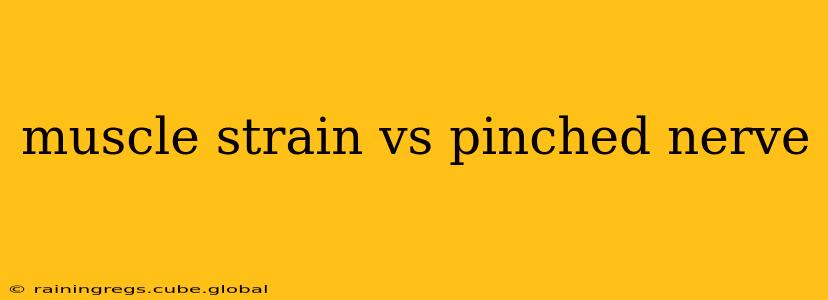Muscle strains and pinched nerves are common sources of pain, often affecting the back, neck, and limbs. While both can cause significant discomfort and limit mobility, they stem from different underlying causes and present with distinct symptoms. Understanding these differences is crucial for seeking appropriate treatment and recovery. This article will delve into the key distinctions between muscle strains and pinched nerves, answering common questions people have about these conditions.
What is a Muscle Strain?
A muscle strain, also known as a pulled muscle, occurs when muscles or tendons are overstretched or torn. This typically happens due to sudden movements, overuse, or inadequate warm-up before physical activity. The severity of a strain can range from mild discomfort to severe pain and loss of function. Common symptoms include:
- Localized pain: The pain is usually concentrated in the affected muscle.
- Muscle spasms: Involuntary muscle contractions can worsen the pain.
- Swelling: Inflammation around the injured area is common.
- Bruising: Discoloration of the skin may occur in more severe cases.
- Limited range of motion: Difficulty moving the affected area freely.
What is a Pinched Nerve?
A pinched nerve, or compressed nerve, happens when surrounding tissues, such as bones, muscles, tendons, or ligaments, put pressure on a nerve. This compression can disrupt the nerve's ability to transmit signals, leading to pain, numbness, tingling, and weakness in the area supplied by that nerve. Causes include poor posture, repetitive movements, spinal degeneration, and injuries. Pinched nerves often present with the following:
- Pain that radiates: The pain isn't just in one spot but travels along the nerve's pathway. This is called radiculopathy.
- Numbness and tingling: A pins-and-needles sensation is characteristic of nerve compression.
- Weakness: Reduced strength in the affected area.
- Burning or shooting pain: The pain may be described as electric or sharp.
What are the common causes of muscle strains?
Muscle strains are frequently caused by activities involving sudden, forceful movements, overuse of a muscle group, or inadequate preparation before physical activity. Examples include:
- Sudden forceful movements: Lifting heavy objects incorrectly, a sudden twist or turn, or a fall.
- Overuse: Repeatedly performing the same action, like typing or playing a sport, without sufficient rest.
- Poor physical condition: Muscles that are weak or inflexible are more susceptible to strains.
- Lack of warm-up: Starting an activity without warming up the muscles increases the risk of injury.
What are the common causes of a pinched nerve?
Pinched nerves result from pressure on a nerve. Several factors can contribute to this compression:
- Poor posture: Slouching, hunching over, or maintaining awkward positions for extended periods.
- Repetitive movements: Repeatedly performing the same motions can irritate and compress nerves.
- Spinal degeneration: Conditions like arthritis and spinal stenosis can narrow the spaces where nerves travel, causing compression.
- Injuries: Traumatic injuries, like whiplash or a herniated disc, can put pressure on nerves.
- Obesity: Excess weight can put added stress on the spine and surrounding nerves.
How are muscle strains diagnosed?
Diagnosing a muscle strain typically involves a physical examination by a doctor or physical therapist. They will assess your symptoms, palpate the affected area, and assess your range of motion. Imaging studies, such as X-rays or ultrasounds, are usually unnecessary unless there's a suspicion of a more serious injury like a fracture.
How are pinched nerves diagnosed?
Diagnosing a pinched nerve often requires a more thorough evaluation. A physical exam assessing reflexes, sensation, and strength is crucial. Imaging tests, such as X-rays, MRIs, or CT scans, might be used to visualize the spine and identify the exact location of the nerve compression. Nerve conduction studies (NCS) and electromyography (EMG) may also be employed to assess nerve function.
What is the treatment for a muscle strain?
Treatment for muscle strains generally involves the RICE method: Rest, Ice, Compression, and Elevation. Over-the-counter pain relievers, like ibuprofen or acetaminophen, can help manage pain and inflammation. Physical therapy may be recommended to improve flexibility, strength, and range of motion.
What is the treatment for a pinched nerve?
Treatment for a pinched nerve depends on the severity and location of the compression. Options may include:
- Rest and modification of activities: Avoiding movements that aggravate the pain.
- Over-the-counter pain relievers: To manage pain and inflammation.
- Physical therapy: To improve posture, strengthen muscles, and improve flexibility.
- Medication: Prescription anti-inflammatory drugs, muscle relaxants, or nerve pain medications may be prescribed.
- Injections: Corticosteroid injections can reduce inflammation around the nerve.
- Surgery: In severe cases, surgery may be necessary to relieve pressure on the nerve.
When should I see a doctor for a muscle strain or pinched nerve?
While many mild muscle strains resolve with home care, seek medical attention if:
- The pain is severe or doesn't improve after a few days.
- You experience significant swelling or bruising.
- You have numbness, tingling, or weakness.
- You suspect a fracture or other serious injury.
For pinched nerves, consulting a doctor is essential for proper diagnosis and treatment, especially if the pain is severe, radiating, or accompanied by neurological symptoms like numbness or weakness.
This information is for general knowledge and does not constitute medical advice. Always consult a healthcare professional for diagnosis and treatment of any medical condition.
